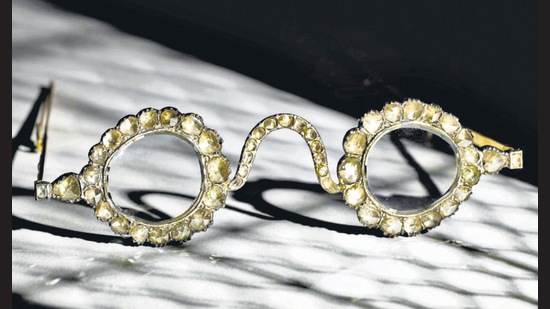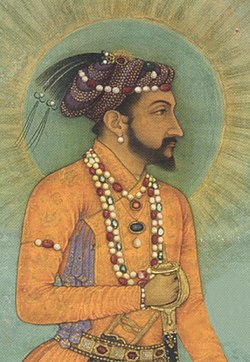When two unique pairs of Mughal-era diamond and emerald spectacles were put on scheduled sale by auction house Sotheby’s in September, they immediately caused a sensation. First, because the asking price was a hefty $3.4 million each. Second, because each pair was an exceptional piece of craftsmanship, and indulgence.
For one pair, a single natural diamond weighing over 200 carats was cleaved to create see-through, crystal-clear diamond lenses. For the other, a similar effect was created using an emerald originally weighing over 300 carats.
The only ingredient missing in these spectacular specimens was the identity of the person who commissioned them. Sotheby’s said the spectacles came from an unnamed princely treasury.
Kohinoor, the 2016 book by William Dalrymple and Anita Anand on the eponymous diamond, offers more clues. On Page 33, it states. “It has recently emerged that after apparently damaging his eyes through excessive weeping over the death of Mumtaz Mahal, Shah Jahan even commissioned two pairs of bejewelled spectacles, one with lenses of diamonds, the other with lenses of emeralds.”
The authors are quoting from a book titled The Mughals and Their Love of Precious Stones (2012) by Ebba Koch, a professor at the Institute of Art History in Vienna and an authority on Mughal India.
It seems likely that Shah Jahan commissioned these spectacles after Mumtaz Mahal’s death in childbirth in 1631. Contemporary court chroniclers have recorded vivid accounts of the emperor’s grief at her demise. Immediately after, he was reportedly inconsolable. He observed mourning for a year, by the end of which his hair had turned white, his back was bent, and his face worn, the accounts state. He poured a fortune into her marble tomb, the Taj Mahal, in Agra.

It is plausible, therefore, that the grief-stricken emperor, perhaps fearing for his health, perhaps on the advice of others, sought the perceived restorative properties of these gemstones. (The diamond spectacles were originally called Halqeh-Ye-Nur or Diamonds for Light, so named because of the association of diamonds with light and the Islamic symbolism of light with the presence of God. Emeralds, meanwhile, were believed to hold miraculous powers to heal and ward off evil.)
Not every king or emperor would have had the economic wherewithal, the inclination, and the taste to create such fine objects. Shah Jahan fits the bill there too.
Making the lenses for the diamond spectacles, for instance, involved slicing up a stone that was originally massive, for two lenses with a combined weight of about 25 carats. This represents a humungous loss that few Indian rulers other than the Mughal emperor could have stomached.
VIEW FINDER
While the diamond used for the lenses is believed to have been from the mines of Golconda in present-day Telangana, the emerald came from the mines of Muzo in Colombia.
Muzo emeralds, known for their rich, sometimes bluish-green tint, were brought to Europe on the ships of Spanish conquistadors. From Europe, Portuguese merchant ships brought these to the Mughal empire, where they became prized status symbols.

The Sotheby’s listings stated that the spectacles were certainly crafted in India, “perhaps during the reigns of Jahangir (r.1605-27), Shah Jahan (r.1628-58), or Aurangzeb (r.1658-1707)”. One can consider Aurangzeb out of the running on account of his famed austerity.
Shah Jahan and his father Jahangir, meanwhile, were both aesthetes and known gemstone connoisseurs. As Dalrymple and Anand write in Kohinoor: “In due course Shah Jahan’s love of beautiful and precious objects outshone even that of his father.”
At the fag-end of his life Shah Jahan may have felt a need for such spectacles. He was bent, feeble, old and lonely, losing his grip on his kingdom to his son Aurangzeb, who would eventually imprison him at the Agra Fort for eight years until his death in 1666.
It’s possible that Shah Jahan made the spectacles, perhaps even as a talisman of sorts. He would have worn them, incidentally, in the manner of a pince-nez.
According to Sotheby’s, both pairs of lenses were created in the 17th century, but the frames are from around 1890. It is not clear which Indian prince the lenses ended up with, or who added the frames and earpieces.
The question of original ownership too “now rests only on probability: who else would have had the resources to risk cleaving an enormous diamond when such an operation could potentially have destroyed one of the biggest and most valuable diamonds ever known? But in truth, no one knows for sure who made those specs,” Dalrymple told Wknd.
The Sotheby’s website states, “It would today be inconceivable to create such excess when cutting an important stone.” The website also states that no other examples of such spectacles are known to exist. That possibly prompted the asking price of $3.4 million. Sadly, there were no takers and Sotheby’s has since withdrawn both pieces.
Enjoy unlimited digital access with HT Premium
Subscribe Now to continue reading

Stay connected with us on social media platform for instant update click here to join our Twitter, & Facebook
We are now on Telegram. Click here to join our channel (@TechiUpdate) and stay updated with the latest Technology headlines.
For all the latest Art-Culture News Click Here
